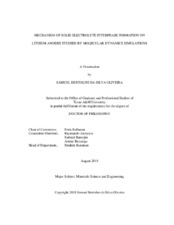| dc.contributor.advisor | Balbuena, Perla B | |
| dc.creator | Bertolini Da Silva Oliveira, Samuel | |
| dc.date.accessioned | 2019-01-18T14:16:03Z | |
| dc.date.available | 2020-08-01T06:37:02Z | |
| dc.date.created | 2018-08 | |
| dc.date.issued | 2018-07-31 | |
| dc.date.submitted | August 2018 | |
| dc.identifier.uri | https://hdl.handle.net/1969.1/173919 | |
| dc.description.abstract | The precipitation of various organic and inorganic products on the Li-metal anode surface, due to electrolyte decomposition, produces a solid-electrolyte interphase (SEI) that controls the battery`s performance. The initial stages of the SEI formation on the Li metal anode surface of lithium-sulfur (Li-S) batteries is studied using First Principles calculations including density functional theory (DFT) and ab initio molecular dynamics (AIMD), and classical molecular dynamics using reactive force fields (ReaxFF).
The reactivity of polysulfides (PS) on the lithium-metal bare surface and on a thin SEI layer covering the anode was studied using AIMD simulations in order to illuminate the degradation of the anode by the PS shuttled from the sulfur cathode in Li-S batteries. The simulations indicate high surface reactivity associated with long-chain PS decomposition on the Li-metal surface. Additionally, the studies suggested a change in reactivity driven by surface orientation. In the presence of a thin SEI layer, the AIMD calculations reveal PS decomposition. The reactivity of PS depends on the nature of the SEI film (e.g. Li2O, LiF), the thickness, and the exposed facet of the SEI layer. Moreover, the PS reactivity changes while it decomposes over the surface and it can stabilize over a period of time, depending on the SEI species formed. The density of states (DOS) calculations indicates a change in the SEI electronic structure, after PS decomposition.
We investigated the initial formation of the SEI on lithium-metal anodes in presence of several electrolyte compositions using ReaxFF, in absence of a bias potential. We observed the formation of well-defined regions with different density and oxidation states of Li. Dissolution of Li metal atoms results in an uneven distribution of Li in the liquid phase. The electrolyte decomposition mechanism was studied for various electrolyte mixtures. Overall, the reaction mechanisms observed with ReaxFF are in good agreement with previous reports using DFT. However, we found some discrepancies in specific predictions by the ReaxFF that should be addressed in future work. | en |
| dc.format.mimetype | application/pdf | |
| dc.language.iso | en | |
| dc.subject | Solid-electrolyte interphase | en |
| dc.subject | Ab initio molecular dynamics | en |
| dc.subject | Reactive Force Fields | en |
| dc.subject | Density Functional Theory | en |
| dc.subject | Lithium Batteries | en |
| dc.title | Mechanism of Solid Electrolyte Interphase Formation on Lithium Anodes Studied by Molecular Dynamics Simulations | en |
| dc.type | Thesis | en |
| thesis.degree.department | Materials Science and Engineering | en |
| thesis.degree.discipline | Materials Science and Engineering | en |
| thesis.degree.grantor | Texas A & M University | en |
| thesis.degree.name | Doctor of Philosophy | en |
| thesis.degree.level | Doctoral | en |
| dc.contributor.committeeMember | Arroyave, Raymundo | |
| dc.contributor.committeeMember | Banerjee, Sarbajit | |
| dc.contributor.committeeMember | Benzerga, Amine | |
| dc.type.material | text | en |
| dc.date.updated | 2019-01-18T14:16:04Z | |
| local.embargo.terms | 2020-08-01 | |
| local.etdauthor.orcid | 0000-0003-2813-0416 | |


